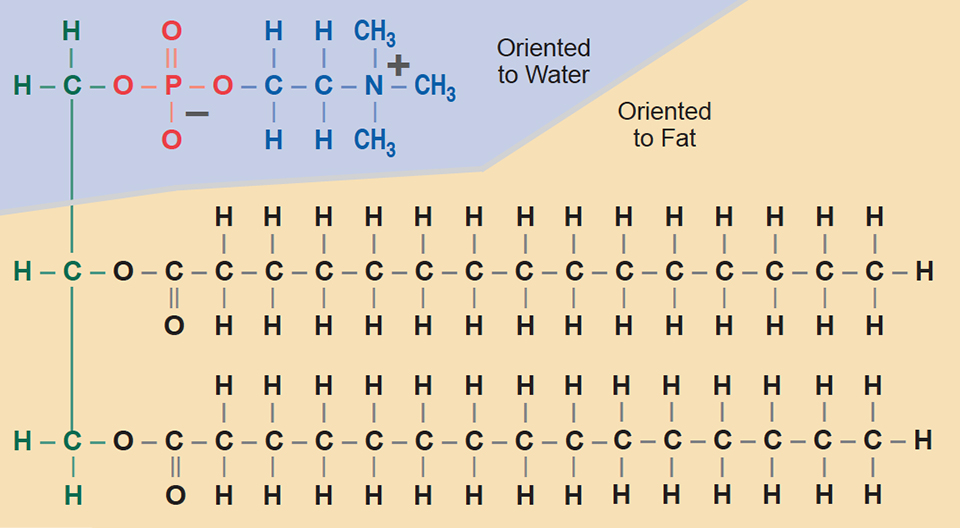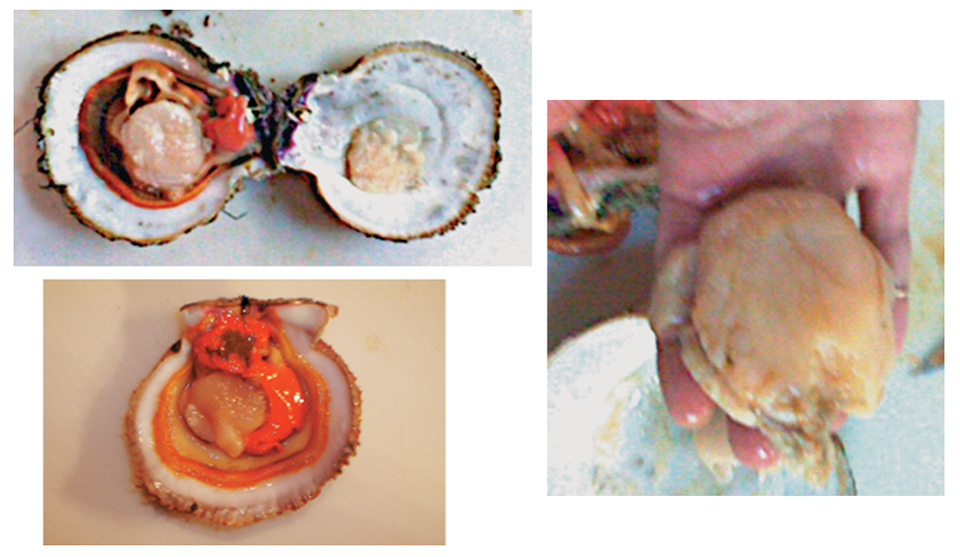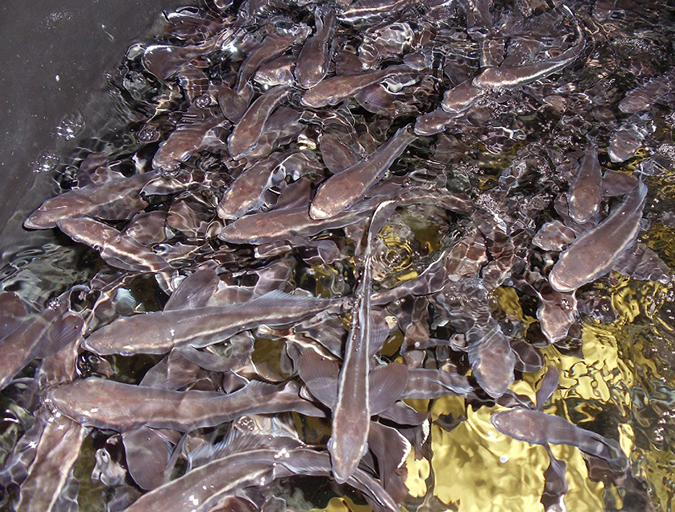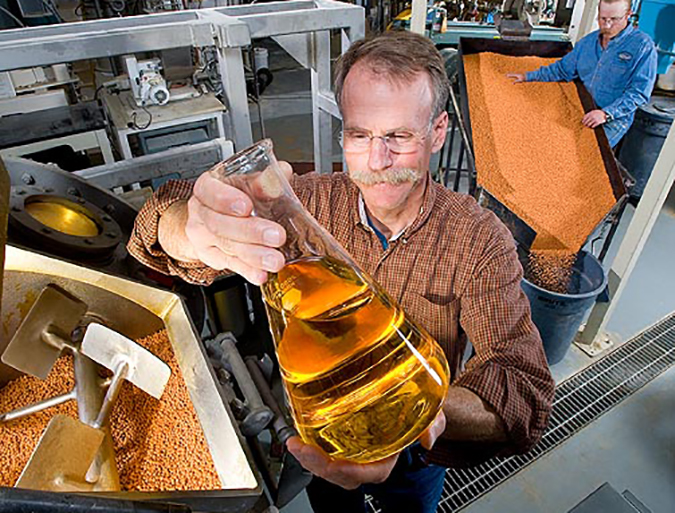Larval stages very sensitive to phospholipid deficiency

Lipids or fat-soluble compounds are a diverse group of molecules that include nutrients such as fatty acids, phospholipids, cholesterol, and vitamins, which are essential for the normal growth and survival of shrimp. Phospholipids are compounds that combine a water-soluble phosphate group at one end with fat soluble fatty acids at the other. This “schizoid” configuration results in physical properties that tend to make them most stable at the interface or boundary of water and fats.
Phospholipids are fundamental components of biological membranes, where their water-soluble “heads” align toward the outside of the membrane, and their fatty tails align toward the inside. Phospholipids are also key components of plasma lipoproteins, which serve to solubilize fats and cholesterol for transport throughout the shrimp hemolymph.
Phospholipids
Several ingredients can provide lecithins or phospholipids in shrimp diets (Table 1). Although marine animal proteins and fats can provide a portion of shrimps’ dietary phospholipids, nutritionists typically formulate shrimp feeds with supplementary phospholipids, commonly in the form of soy lecithin. Increased knowledge of the need for phospholipids by shrimp; the variability and cost of marine animal sources of phospholipids; and the availability, consistency, and phospholipid content of soy lecithin have resulted in widespread use of soy lecithin in shrimp feeds.
Russett, Approximate phospholipid content of aquafeed ingredients , Table 1
| Ingredient | Phospholipid, % |
|---|---|
| Clam meal | 1.27 |
| Egg powder | 2.14 |
| Fish meal | 2.47 |
| Krill meal | 2.03 |
| Oyster meal | 16.26 |
| Shark liver oil | 2.50 |
| Shrimp head meal | 3.82 |
| Shrimp meal | 1.02 |
| Squid liver meal | 6.36 |
| Squid liver oil | 1.53 |
| Squid meal | 3.39 |
| Squid oil | 0.76 |
| Tuna meal | 0.50 |
| Yeast, torula | 1.27 |
Functions of phospholipids
Digestion. Lecithins were thought to be required as a surfactant for lipid emulsification and digestion, but more recent evidence suggests that dietary phospholipids improve growth and survival by effects other than enhancement of emulsification and absorption of dietary lipid from the digestive tract.
Lipid utilization. Dietary phospholipids influence lipid mobilization (e.g., cholesterol and triglycerides) from the midgut gland to the hemolymph and other extrahepatic tissues, rather than affect their direct digestion and absorption.
Shrimp cannot effectively utilize dietary lipids, especially cholesterol, for growth and survival in the absence of supplemental soybean lecithin. Dietary phospholipids enhance lipid deposition and increase energy available for growth, and may also improve the efficiency of essential fatty acids supplied as neutral lipid, thus reducing requirements for n-3 highly unsaturated fatty acids (HUFA). This positive interaction between phospholipids and HUFA may contribute to improved resistance of shrimp to adverse growing conditions, such as osmotic and salinity stress.
Phospholipids may be superior to triacylglycerols as essential fatty acid sources for larval stages, whose digestive capacity may not be fully developed. Phospholipids are more polar and may be more fully emulsified for absorption.
Cholesterol. Cholesterol is an important cell membrane component. It helps yield a more rigid, ordered structure to the fluid lipid bilayers, and also increases the bilayer fluidity in the solid state. It is the precursor of steroidal hormones for molting, growth, and reproduction, and is part of the crustacean hypodermis.
Dietary phospholipids improve the mobilization of cholesterol and triglycerides from the digestive tract to the hepatopancreas, hemolymph, and muscle. A recent study showed a significant interaction between dietary phospholipid and cholesterol requirements, reporting that 0.4 percent cholesterol was required for optimal growth of juvenile Penaeus vannamei without dietary phospholipid, 0.2 percent cholesterol when 1.5 percent to 3 percent phospholipids (deoiled soy lecithin) was in the diet, and 0.1 percent cholesterol when 5 percent phospholipids was supplemented. These results are similar to the observation that P. vannamei, under outdoor conditions, require 0.2 percent to 0.4 percent cholesterol when their diet has 1 percent lecithin.
Phosphatidylcholine and phosphatidylinositol. Although soy lecithin can prevent choline and inositol deficiencies, choline and inositol salts cannot replace or reduce the dietary needs for phosphatidylcholine and phosphatidlyinositol in shrimp. These compounds are required by shrimp as intact phospholipids.
Protein. A protein-lipid interaction has been suggested, where the better the amino acid profile of the dietary protein relative to the nutritional need of the shrimp, the greater the growthpromoting effect of soybean lecithin.
Reproduction. Soybean lecithin improves nauplii production, percent hatch, and sperm counts. A specific, unidentified component of the soybean lecithin might cause this effect on broodstock.
Phospholipids below 2 percent in broodstock diets depress spawning frequency and egg number per spawn in P. vannamei, and appear to be essential during penaeid vitellogenesis, larvae development, and juvenile growth.
Pigments. Phospholipids enhance the absorption of various drugs, including their lipid permeability, which is important to the use of carotenoids in shrimp nutrition. Carotenoids prevent the “blue shrimp” pathology and play a role in egg development during embryonic and post-embryonic development stages. These fat-soluble pigments are poorly absorbed and retained.
A synergy could exist between phospholipids and carotenoids in the nutrition of shrimp. An extra amount of lysolecithin above the amount of native lecithin providing nutritional merit may have a special functional role in nutrient absorption, such as for carotenoids.
Shrimp feeding needs. Shrimp nibble on feed particles, resulting in substantial nutrient losses (greater than 20 percent protein, 50 percent carbohydrate and 85 percent to 95 percent vitamins). Lecithins reduce leaching of water-soluble nutrients and act as effective binders. Dietary phospholipids may play a role in improved shrimp food palatability through chemoattraction, and in improving physical properties of manufactured feeds.
Phospholipids requirements of shrimp
Crustaceans can synthesize phospholipids but their biosynthesis cannot meet metabolic requirements during juvenile and earlier stages. Optimal performance may require higher phospholipids levels than those needed for survival.
The need for phospholipids (e.g., soybean lecithin generally or phosphatidylcholine specifically) has been determined for several shrimp species (Table 2). For most crustacean species, estimated phospholipid requirement for larvae is in the range of 1 percent to 3 percent phosphatidylcholine plus phosphatidylinositol. This phospholipid requirement is fulfilled by 3 percent to 9 percent standard fluid soy lecithin or 2 percent to 6 percent dry, deoiled soy lecithin (95 percent to 97 percent A.I.).
Russett,
| Species | Dietary Phospholipid Fortification |
|---|---|
| Penaeus japonicus | 1.5% phosphatidylcholine to 6.5% soy lecithin (86% phospholipid) |
| Penaeus chinensis | 2% soy lecithin |
| Juvenile Penaeus merguiensis | 1 - 2% soy lecithin (60% phospholipids) |
| Juvenile Penaeus penicillatus | 1.25% phosphatidylcholine |
| Juvenile Penaeus monodon | 1.25% phosphatidylcholine |
| Postlarval Penaeus monodon | 1 to 2% soy lecithin (63% phospholipids) |
| Penaeus stylirostris | 1.5% soy lecithin |
| Postlarval Penaeus vannamei | 1.5% phosphatidylcholine to 6.5% soy lecithin (86% phospholipids) |
Crustacean larval stages are very sensitive to phospholipid deficiency. For example, Zoea I/II stages of P. japonicus suffered 100 percent mortality before reaching mysis stage when fed a phospholipid-deficient diet.
Requirements change with species and age
The phospholipid requirement generally decreases with age or development stage. Kanazawa (1993) reported a decrease in phospholipid requirements from 5 percent to 3 percent soybean lecithin (equivalent with 1.6 percent to 1.0 percent phosphatidylcholine plus phosphatidylinositol) from larva to juvenile.
The phospholipid need for juveniles of different penaeid shrimp are mostly within the range of 1.2 percent to 1.5 percent active phospholipid (i.e., phosphatidylcholine plus phosphatidylinositol). This would be equivalent to 3.75 percent to 4.5v fluid soy lecithin or 2.5 percent to 3 percent deoiled soy lecithin.
Published recommended levels of dietary soybean lecithin vary from 1.25 percent to 6.5 percent, depending on shrimp species and developmental stage. Since the purity and composition of the phospholipids in soybean lecithin have varied from study to study, drawing conclusions concerning optimal levels/types of dietary phospholipids required by different shrimp is difficult.
Conclusions
Phospholipids are essential nutrients required for growth and survival of larval and juvenile crustaceans. They are involved in mobilization of cholesterol and triglycerides from the midgut. They provide a bioavailable source of choline and inositol, facilitate pigment absorption, and reduce dietary nutrient leaching while improving pellet binding. The phospholipid requirement for larval shrimp is in the range of 3 percent to 9 percent from soy lecithin, in order to supply 1 percent to 3 percent phosphatidylcholine plus phosphatidylinositol. The phospholipid need for juvenile shrimp is within the range of 3.75 percent to 4.5 percent soy lecithin (1.2 percent to 1.5 percent phosphatidylcholine plus phosphatidylinositol). The phospholipid requirement for broodstock is at least 2 percent soy lecithin (0.65 percent phosphatidylcholine plus phosphatidylinositol).
(Editor’s Note: This article was originally published in the October 2000 print edition of the Global Aquaculture Advocate.)
Now that you've reached the end of the article ...
… please consider supporting GSA’s mission to advance responsible seafood practices through education, advocacy and third-party assurances. The Advocate aims to document the evolution of responsible seafood practices and share the expansive knowledge of our vast network of contributors.
By becoming a Global Seafood Alliance member, you’re ensuring that all of the pre-competitive work we do through member benefits, resources and events can continue. Individual membership costs just $50 a year.
Not a GSA member? Join us.
Author
-
J.C. (Craig) Russett, Ph.D.
Director of Agri-Business
Central Soya Co.
Fort Wayne, IN 46801-1400 USA[109,111,99,46,100,108,114,111,119,115,98,101,46,115,117,64,116,116,101,115,115,117,114,99]
Tagged With
Related Posts

Aquafeeds
A look at phospholipids in aquafeeds
Phospholipids are the major constituents of cell membranes and are vital to the normal function of every cell and organ. The inclusion of phospholipids in aquafeeds ensures increased growth, better survival and stress resistance, and prevention of skeletal deformities of larval and juvenile stages of fish and shellfish species.

Health & Welfare
Alaska’s purple-hinge rock scallops considered for aquaculture development
Purple-hinge rock scallops are highly prized by local communities and harvested for subsistence in coastal Alaska. To evaluate the suitability of purple-hinge rock scallops for mariculture in Alaska, the authors conducted a four-year grow-out study.

Aquafeeds
Is a fish oil-free cobia feed possible?
The availability of a cost-effective grow-out feed formulation is an ongoing bottleneck for the expansion of cobia production. Studies by the authors show that the development of an aquafeed with limited or no fish oil content is possible.

Aquafeeds
Aquaculture Exchange: Rick Barrows
After 14 years with the USDA’s Agricultural Research Service, Rick Barrows talks about the importance of finding ‘complete’ and commercially viable alternative sources of omega-3 fatty acids and continuing innovation in the aquafeed sector.


